Scottish Greenhouse Gas statistics: 1990-2019
The Scottish Greenhouse Gas Inventory is the key tool for understanding the origins and magnitudes of greenhouse gas emissions in Scotland. The inventory is compiled in line with international guidance from the Intergovernmental Panel on Climate Change.
Section B. Results – Net Sources of Scottish Greenhouse Gas Emissions
2019 results
Chart B1 presents the sources and sinks of Scottish Greenhouse Gas Emissions in 2019, grouped by Grouped by National Communication category.
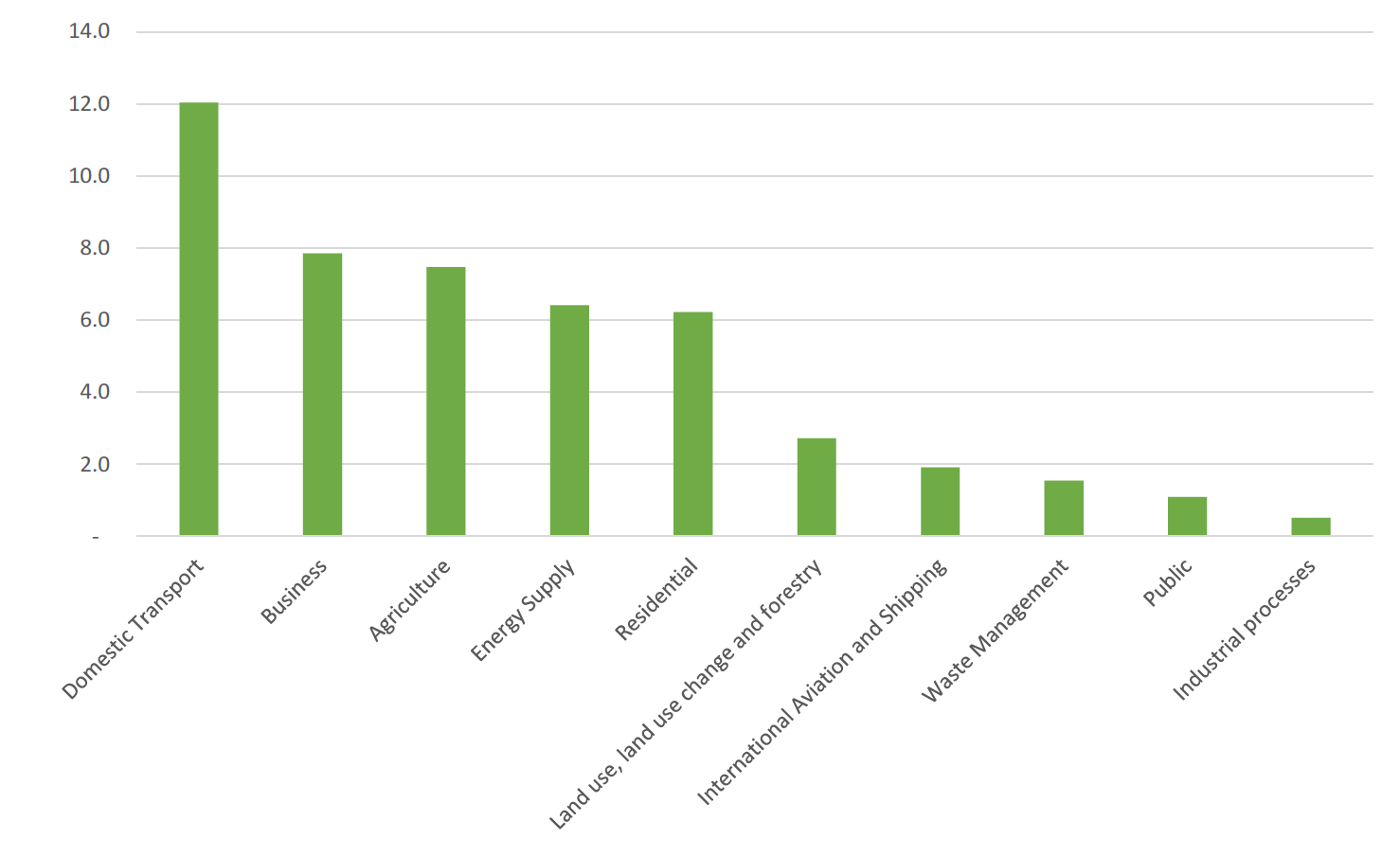
Main points
- In 2019, Domestic transport (excluding International Aviation and Shipping) (12.0 MtCO2e) was the largest source of net emissions, followed by Business (7.9 MtCO2e), Agriculture (7.5 MtCO2e), Energy Supply (6.4 MtCO2e) and Residential (6.2 MtCO2e).
| NC category | Carbon Dioxide | Methane | Nitrous Oxide | Fluorinated gases | Total |
|---|---|---|---|---|---|
| Agriculture | 1.1 | 4.1 | 2.2 | 7.5 | |
| Business | 6.7 | 0.0 | 0.1 | 1.1 | 7.9 |
| Energy Supply | 6.0 | 0.4 | 0.1 | 6.4 | |
| Industrial Processes | 0.5 | 0.0 | 0.0 | 0.0 | 0.5 |
| International Aviation and Shipping | 1.9 | 0.0 | 0.0 | 1.9 | |
| Land Use, Land Use Change And Forestry | -1.7 | 3.2 | 1.2 | 2.7 | |
| Public | 1.1 | 0.0 | 0.0 | 1.1 | |
| Residential | 6.0 | 0.1 | 0.0 | 0.1 | 6.2 |
| Transport | 11.9 | 0.0 | 0.1 | 12.0 | |
| Waste Management | 0.0 | 1.4 | 0.1 | 1.5 | |
| Total | 33.5 | 9.2 | 3.8 | 1.2 | 47.8 |
Main points
Carbon dioxide was the main greenhouse gas emitted or removed in most sectors, with the exceptions of the Agriculture, LULUCF and Waste Management sectors.
- Methane was the main net gas emitted in the Agriculture (4.1 MtCO2e), followed by nitrous oxide (2.2 MtCO2e) and carbon dioxide (1.1 MtCO2e).
- Almost all emissions in the Waste Management sector were emitted in the form of methane (1.4 MtCO2e).
Where F gases are emitted, they have been in relatively small amounts via the Business and Residential sectors.
Key Trends By Scottish Government Source Sector
Chart B2 presents the main sources of Scottish Greenhouse Gas Emissions from 1990 to 2018, broken down by National Communication categories. Chart B3 and Chart B4 specifically explore the trend in Energy Supply emissions. Chart B5 contains information on the reductions in greenhouse gas emissions in every National Communication category over the entire time period, with Chart B6 containing the same information for the latest year.
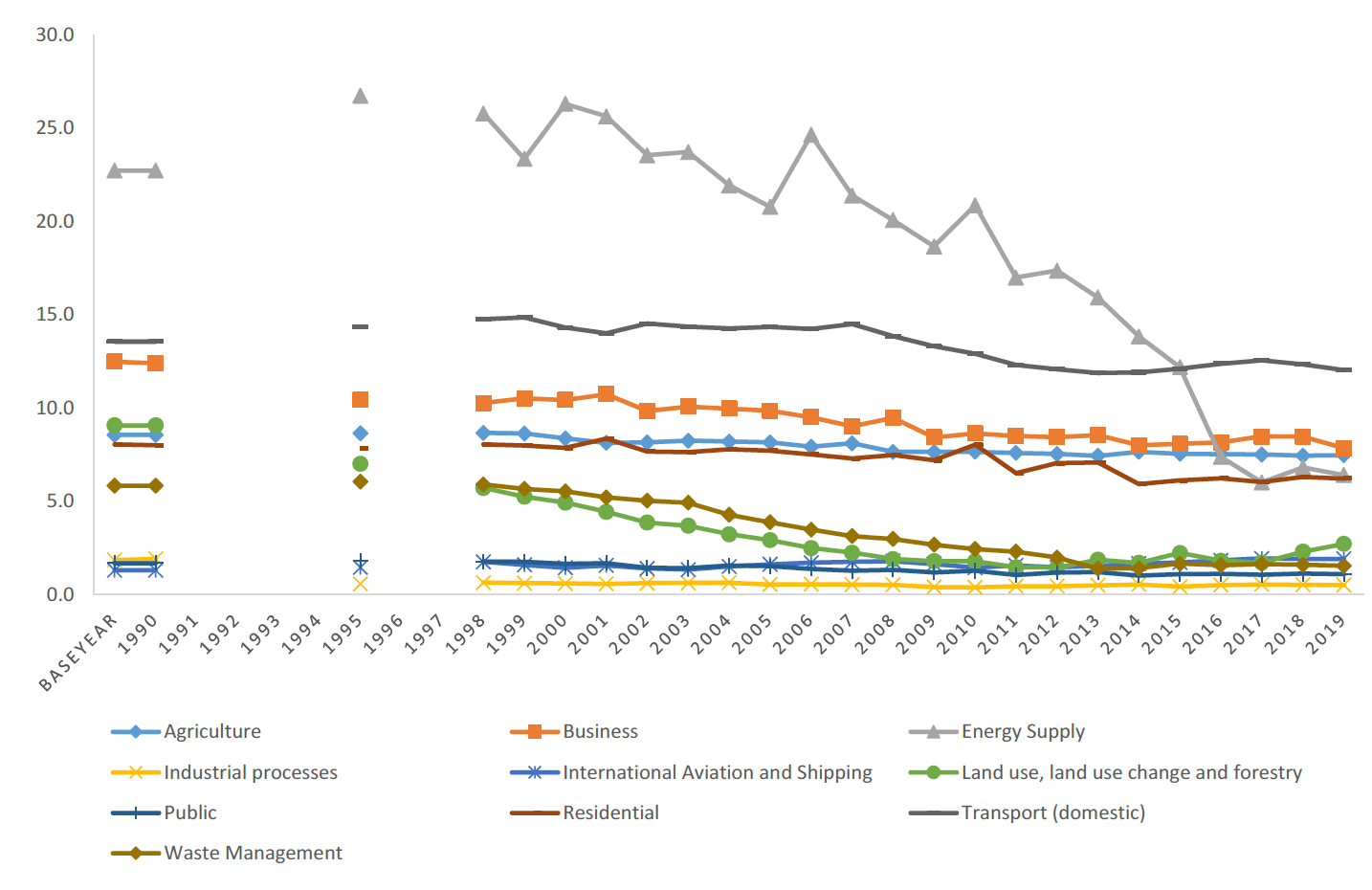
Main Points
Most sectors exhibit a general downwards trend between 1990 and 2019:
- Energy Supply emissions have seen the largest decrease in GHG emissions (-16.3 MtCO2e, a reduction of 71.8 per cent) followed by LULUCF (-6.4 MtCO2e, a reduction of 70.0 per cent), Business (-4.6 MtCO2e, a reduction of 36.7 per cent), and Waste Management (-4.3 MtCO2e, a reduction of 73.5 per cent)
- International Shipping and Aviation emissions are the only category to have increased (0.6 MtCO2e, a 46.0 per cent increase) over the period.
Chart B3 shows how the generation of Scotland's electricity has changed over time. Emissions from the electricity supply sector (such as power stations) are associated with these changes.
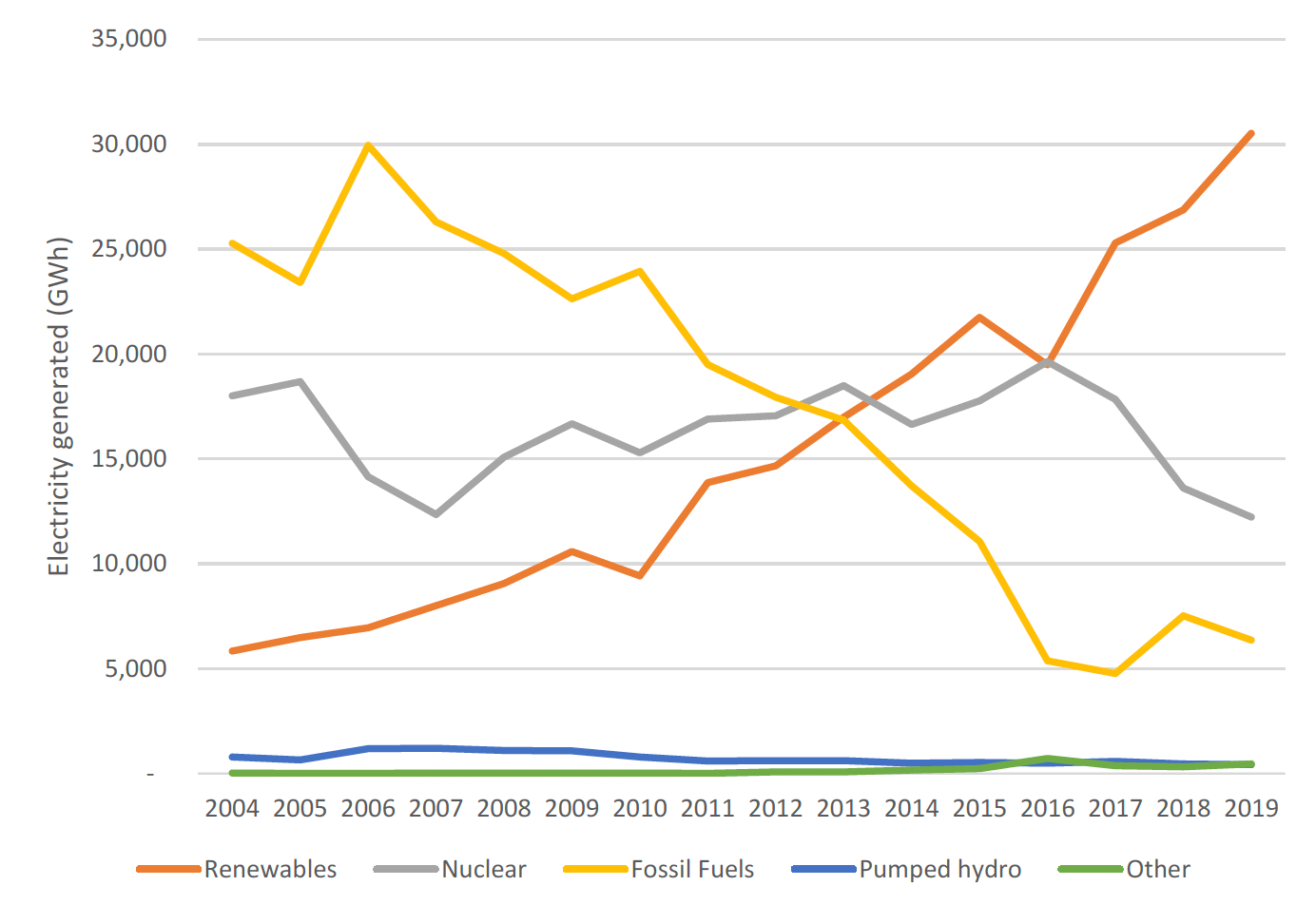
Data obtained from Scottish Energy Statistics Database[4]
Main Points
Overall, the gigawatt-hours of electricity generated in Scotland increased by 2.5 per cent between 2018 and 2019. Renewables were the single largest source of electricity generated in Scotland in 2019 at 61.1 per cent, followed by nuclear generation at 24.5 per cent with fossil fuel generation making up only 12.7 per cent.
Long term (1990 to 2019) and short term (2018 to 2019) trends by category
Chart B4 shows how emissions have changed between 1990 and 2019 in all source categories. Chart B5 shows how emissions have changed between 2018 and 2019.
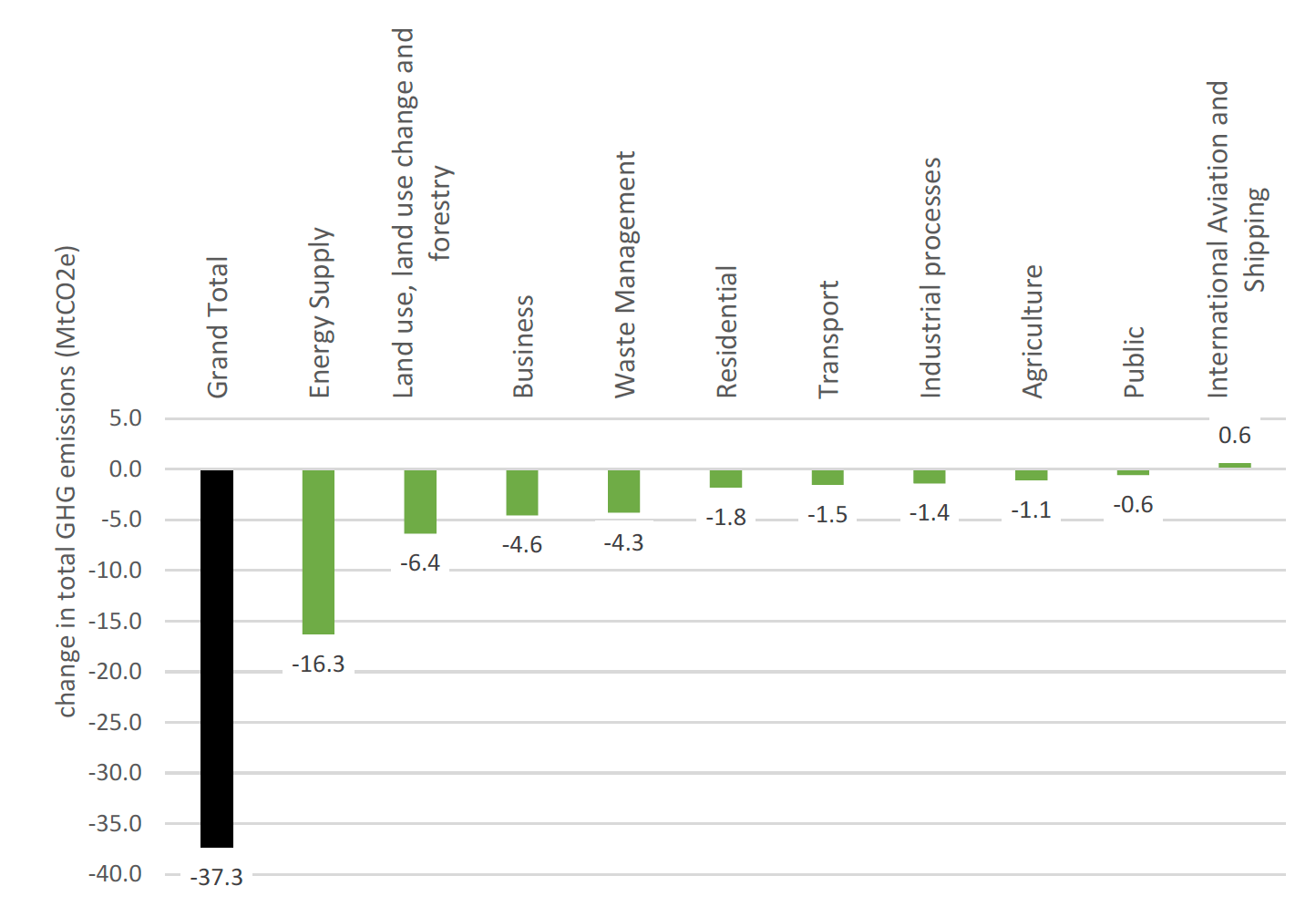
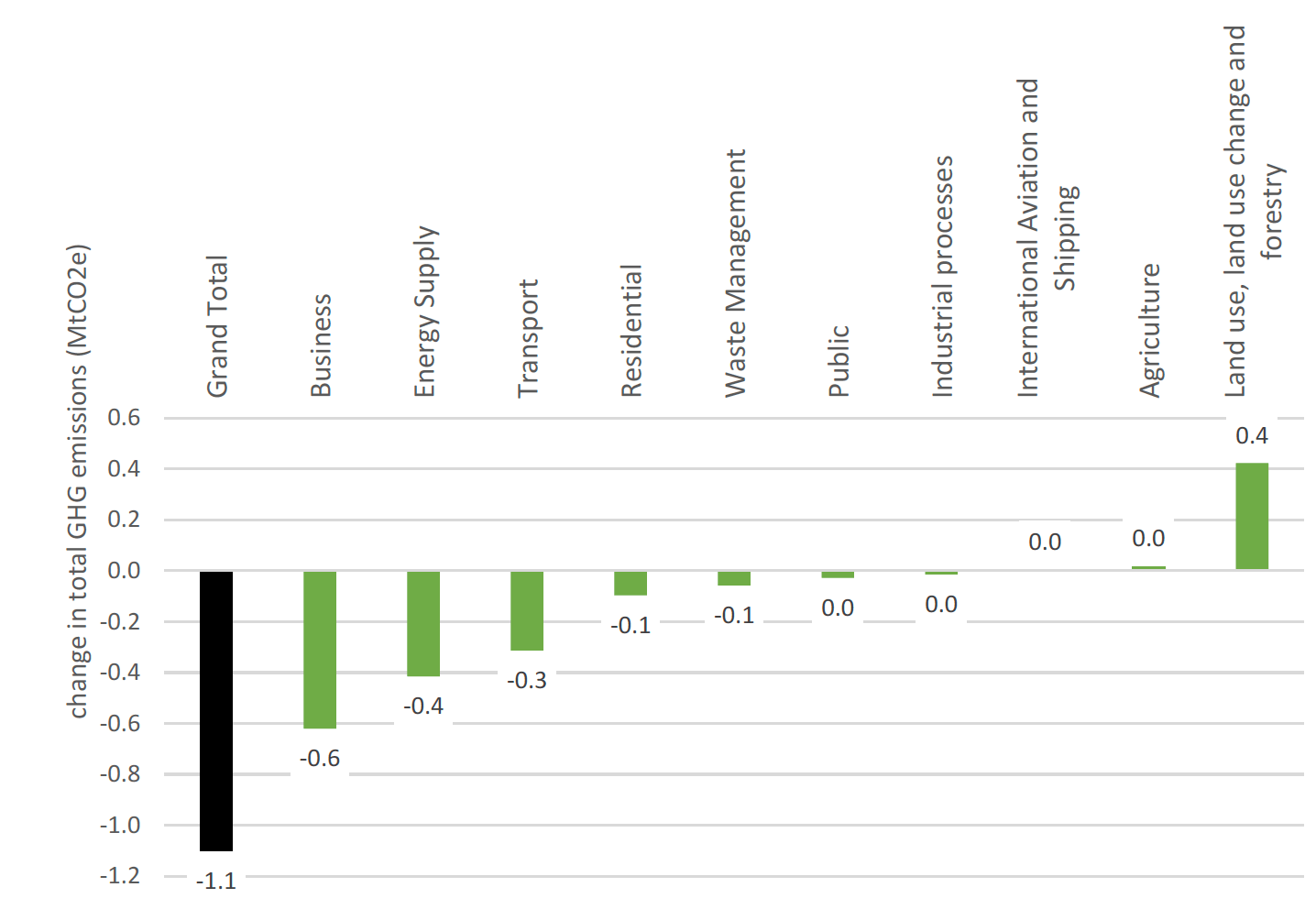
Total Emissions
Overall, there has been a 37.3 MtCO2e (43.8 per cent) decrease in net emissions between 1990 and 2019. Total emissions have reduced by 1.1 MtCO2e (2.3 per cent) between 2018 and 2019.
Land Use, Land Use Change And Forestry (LULUCF)
As a result of a major revision to the scope of the GHG inventory in Scotland and the UK in this latest release, LULUCF emissions are now shown to be a net-source of greenhouse gas emissions for all periods. Previously this category has been shown to be a net-sink of GHG emissions. The reason for this revision is the inclusion of the effect of historical drainage and rewetting of peatlands that previously were not included in the data. These revisions are discussed further in section D below. LULUCF is now a net source of GHG emissions in Scotland, emitting 2.7 MtCO2e of emissions in 2019. In 1990 emissions were 9.1 MtCO2e.
Domestic Transport
Domestic Transport has consistently been a large part of Scotland's emissions, with a relatively small decrease of 11.3 per cent between 1990 (13.6 MtCO2e) and 2019 (12.0 MtCO2e). Historically it was second only to Energy Supply, however the decline in Energy Supply emissions has left domestic transport as the leading emitter since 2016.
Transport emissions have decreased by 0.3 MtCO2e (2.5 per cent reduction) between 2018 and 2019.
Energy Supply
Energy Supply was historically the biggest contribution to emissions, but has seen large changes over the period covered by these statistics, reducing from 22.7 MtCO2e in 1990 to 6.4 MtCO2e in 2019 ( 71.8 per cent reduction). Overall Emissions reductions in this sector are mainly due to reductions in emissions from power stations and the complete cessation of coal use for electricity generation in Scotland.
Between 2018 and 2019 Energy Supply emissions decreased by 0.4 MtCO2e (6.1 per cent decrease). This decrease was driven by an decrease in CO2 emissions from power stations. Chart B3 shows the decrease in fossil fuel use for power generation in 2019.
Business
This sector has seen a 4.6 MtCO2e (36.7 per cent) fall in emissions between 1990 and 2019. As shown in Chart B2, much of this decrease occurred between 1990 and 1995 – linked to a decline in emissions from manufacturing and the iron and steel industry over this time period. There was a further smaller decrease between 2008 and 2009 (1.1 MtCO2e decrease) , coinciding with the recession. Between 2018 and 2019 there was a relatively large 0.6 MtCO2e decrease in business emissions.
Agriculture
This sector has seen a 1.1 MtCO2e (12.7 per cent) fall in net emissions between 1990 and 2019. Between 2018 and 2019 there was essentially no change in net emissions of overall greenhouse gases from this sector.
Residential
The residential sector is dominated by direct fuel combustion in households. There has been a reduction of 22.3 per cent between 1990 and 2019. This long-term decrease is mainly due to a switch from less efficient solid and liquid fuels to natural gas for heating, and improvements in energy efficiency.
Residential emissions have decreased very slightly between 2018 and 2019 from 6.3 MtCO2e to 6.2 MtCO2e (1.5 per cent reduction). This marginal change in emissions was possibly driven by a warmer January-March in 2019 compared to 2018, resulting in less fuel burned for domestic heating (Chart B6).
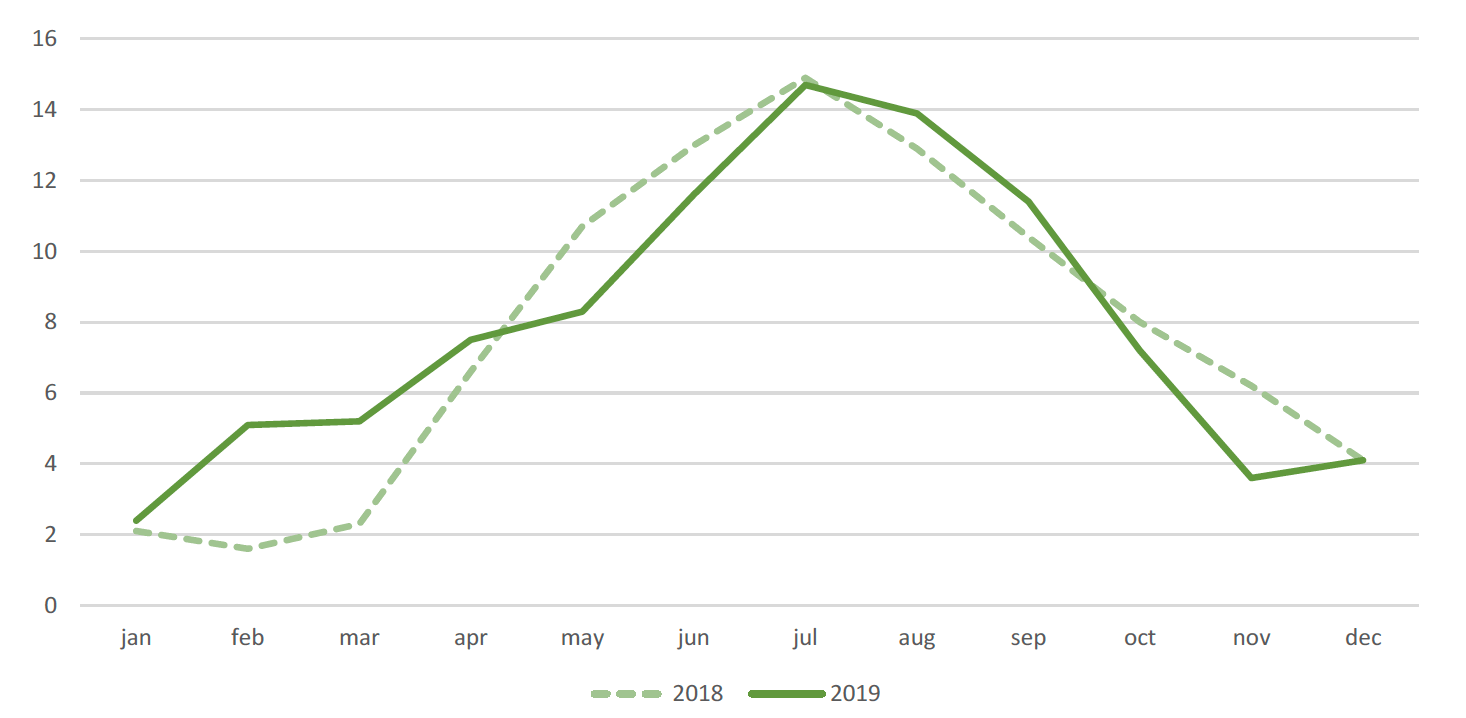
Data obtained from Met Office[5]
International Aviation and shipping
International aviation has increased by 0.6 MtCO2e (46.0 per cent) from 1990 to 2019. There was little change between 2018 and 2019, with the value remaining at 1.9 MtCO2e.
Waste Management
Waste management emissions tend to be dominated by methane emissions. Emissions from Waste Management have been relatively static over recent years, with a value of 1.5 MtCO2e for 2019, very slightly down from 1.6 MtCO2e between 2016-2018. However, between 1990 and 2019 emissions reduced by 4.3 MtCO2e (73.5 per cent). This decrease is largely due to the progressive introduction of methane capture and oxidation systems within landfill management.
Public
The main source of emissions from this sector is the use of natural gas for heating public buildings. There was a 0.6 MtCO2e (34.9 per cent) fall in emissions from public sector buildings between 1990 and 2019. Emissions over the last few years have been relatively flat, with a value of 1.1 MtCO2e between 2015 and 2019.
Industrial Processes
This sector has seen a 1.4 MtCO2e (73.1 per cent) decrease from 1990 to 2019. Values have been relatively stable over the last couple of decades, with 2018 having a value of 0.5 MtCO2e. Most of the decrease in the sector happened between 1990 and 1995, and was associated with decreased emissions in the Nitric acid production industry and from a process known as sintering – a process that used to be associated with the iron and steel industry.
Emissions by type of gas
Chart B7 shows the trends in emissions, broken down by gas from 1990 to 2019.
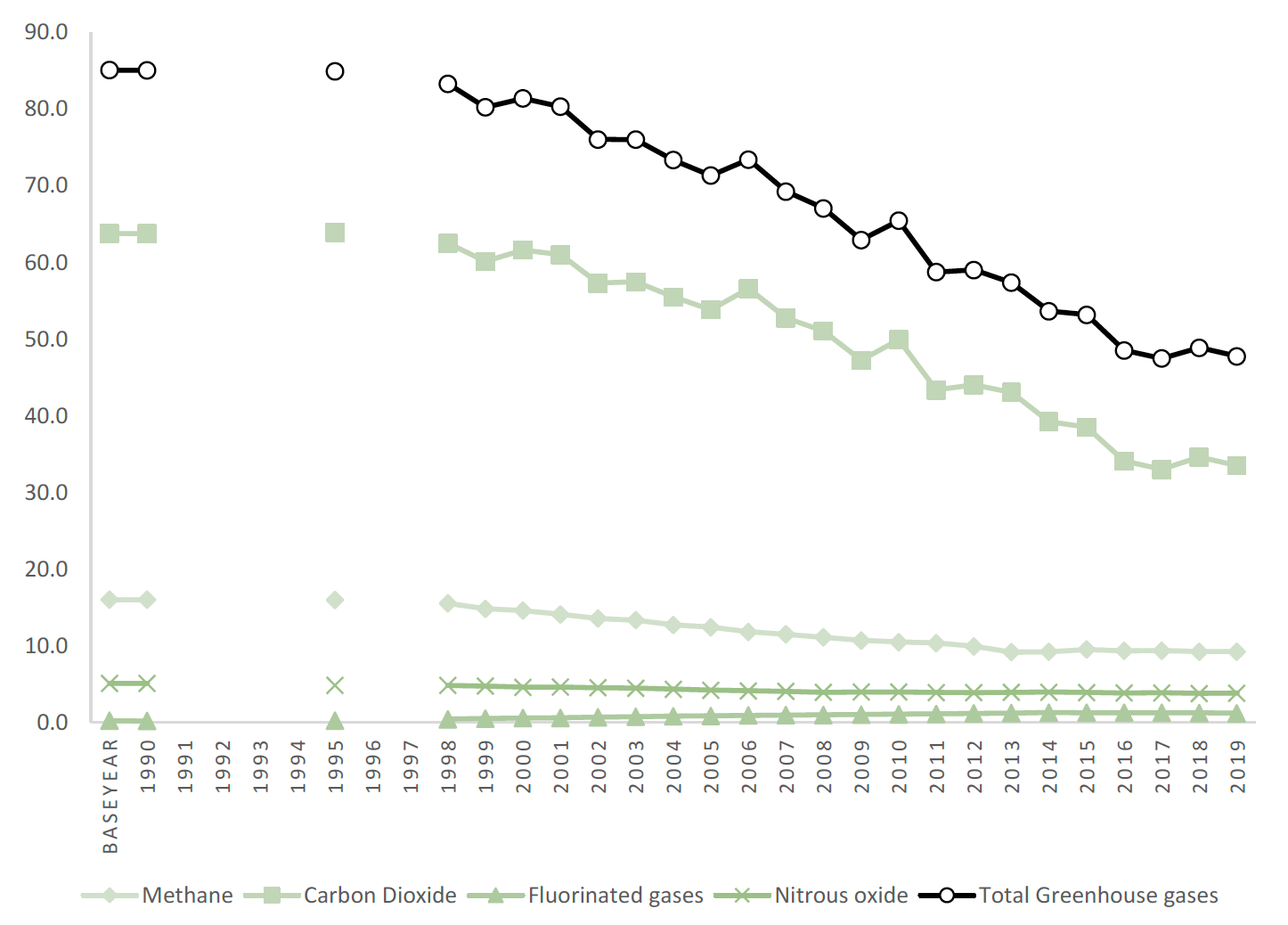
Main Points
- Carbon dioxide is by far the largest contributor to Scottish greenhouse gas emissions in all years (70.2 per cent of all emissions in 2019) and is the most volatile series of all gases – largely driven by changes in energy supply emissions and to a lesser extent, emissions from the residential and business categories.
- Methane is the second most common greenhouse gas in 2019 (19.3 per cent of all net emissions) followed by nitrous oxide (8.0 per cent) and F-gases making up the remainder (2.5 per cent).
- Carbon dioxide has seen the largest reduction from 1990 to 2019 (30.3 MtCO2e reduction). There have also been reductions in both methane (6.8 MtCO2e reduction) and nitrous oxide (1.3 MtCO2e reduction). Emissions from fluorinated gases have shown a large increase from 1990 to 2019, although they still remain small in absolute terms, driven by the introduction of hydrofluourocarbons (HFCs) from 1995 onwards. These HFCs replace chlorofluorocarbons (CFCs) which were banned by the Montreal Protocol due to their impact on the ozone layer.
Charts B8 to B11 present results on individual gases broken down by main sectors over time. Chart B8 shows how carbon dioxide emissions have changed from 1990 to 2019.
Carbon Dioxide (CO2)
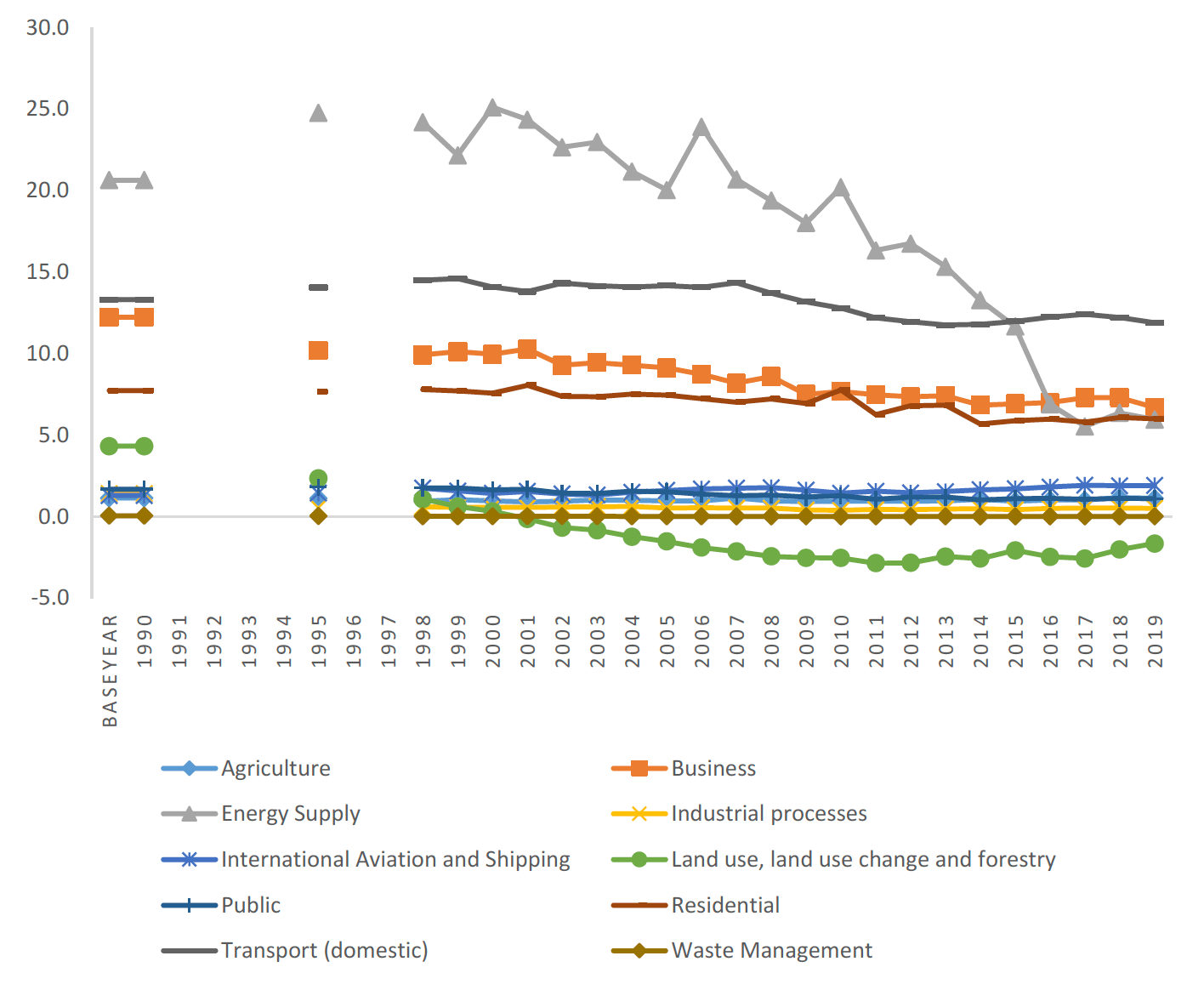
Main Points
- Chart B8 shows that Energy Supply is a key source of carbon dioxide emissions in all years between 1990 and 2015, after which the change in fuels used in electricity generation substantially reduces CO2 emissions from this source. Change in energy supply emissions is the main driver of changes in total carbon dioxide emissions. Emissions from this category have been volatile, with the highest emissions occurring between 1995 and 2003, and a spike in 2006, related to a greater use of coal in that year.
- Transport (excluding international) is the next most common source of carbon dioxide emissions across the entire time-series. In 2015 Transport became the highest source of emissions for the first time in the time series.
- Despite revisions to total greenhouse gases for the LULUCF sector, it has become a much greater net CO2 sink for Scotland over the period. In 1990 it emitted 4.3 MtCO2 of net CO2 emissions. From 2001, this sector became a net-CO2 sink, reaching a maximum in 2011 when it acted to sequestrate 2.9 MtCO2. Since that time, this net CO2 sink has been generally reducing to its current (2019) level where it sequestrated 1.7 MtCO2. These trends reflect forestry planting activities in the early 1990s reaching maturity and gradually reducing its potential to remove CO2.
Methane (CH4)
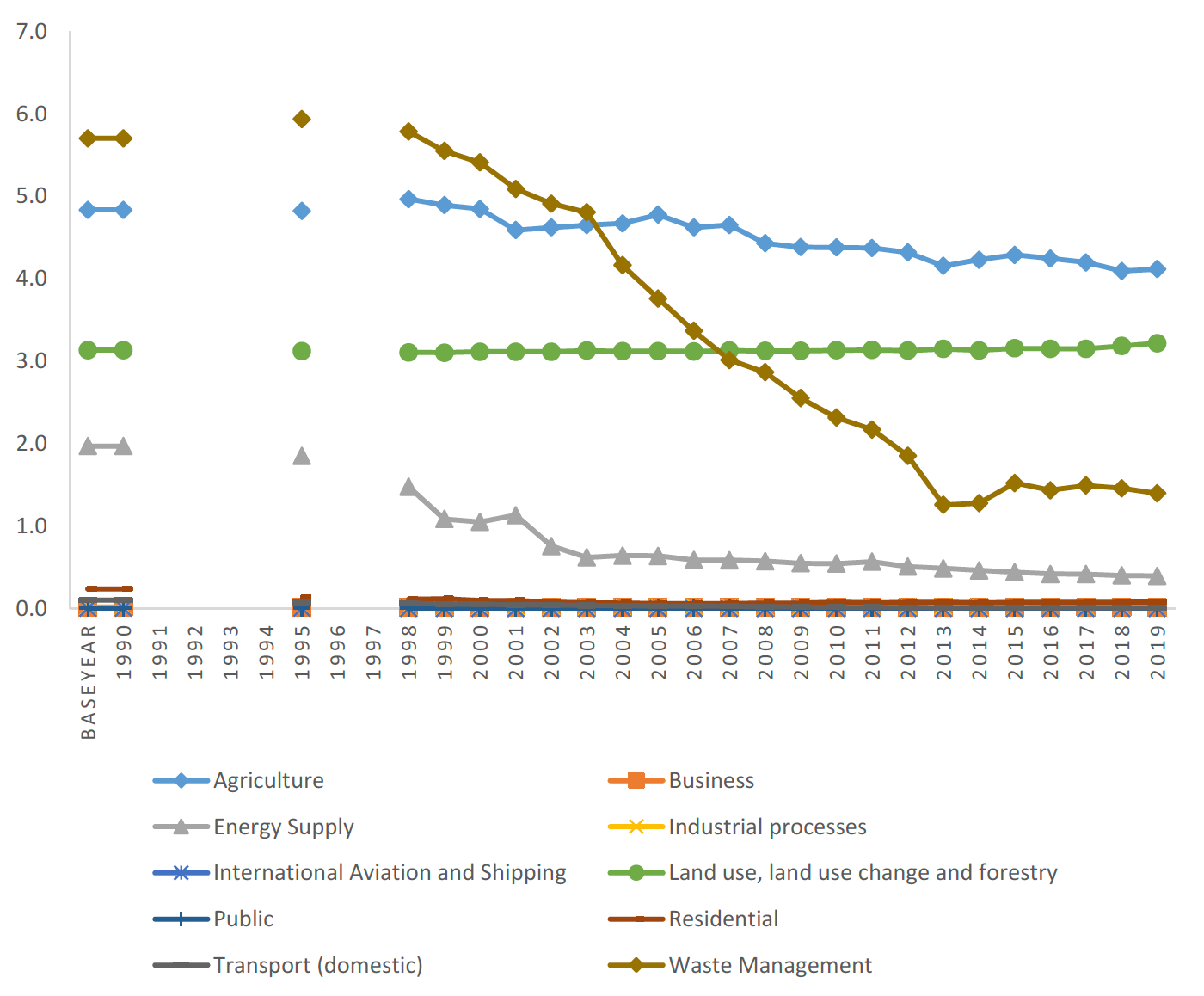
Main Points
- Methane emissions from Waste Management have fallen by 4.3 MtCO2e between 1990 and 2019 (a 75.5 per cent reduction). This is largely due to the progressive introduction of methane capture and oxidation systems within landfill management.
- Methane emissions in the Agriculture sector have fallen by 0.7 MtCO2e between 1990 and 2019 (an 14.9 per cent reduction). This is mainly due to a decrease in livestock numbers (particularly cattle and sheep).
- In the Energy Supply sector, methane emissions have fallen by 1.6 MtCO2e between 1990 and 2019 (a 80.0 per cent reduction), partly due to reductions in emissions from sources such as coal mining.
- Land Use emissions of methane have remained essentially flat over the entire time-series, rising very slightly by 0.1 MtCO2e.
Nitrous Oxide (N2O)
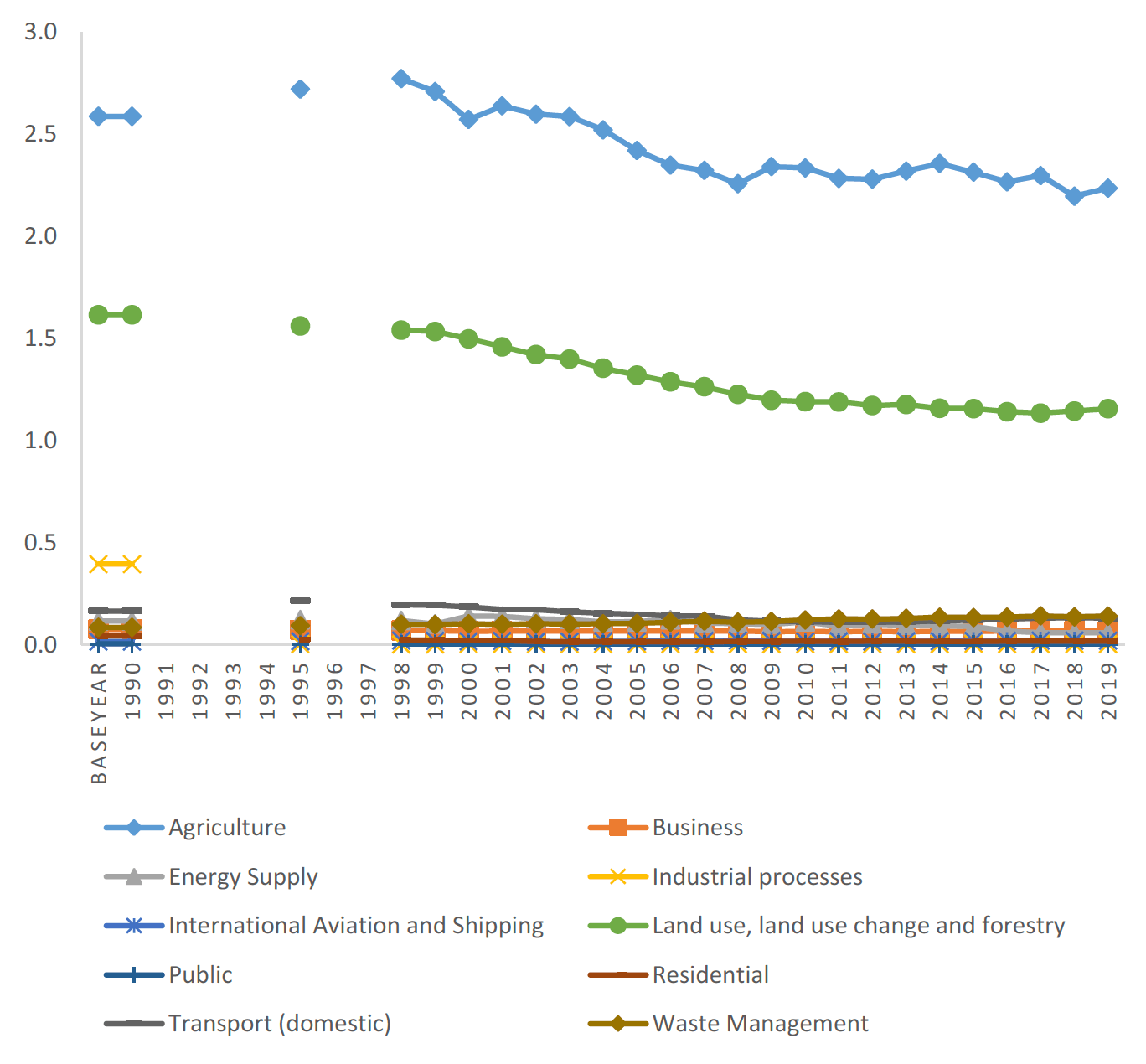
Main Points
- Agriculture is by far the main contributor to emissions of nitrous oxide. These are largely produced by agricultural practices on soils, and to a lesser extent by animal manures. Emissions of nitrous oxide in this sector have fallen by 0.4 MtCO2e between 1990 and 2019 – A 13.6 per cent reduction.
- 'Land Use, Land Use Change And Forestry' fell by 0.5 MtCO2e (28.5 per cent reduction) between 1990 and 2019.
Fluorinated gases (F-gases)
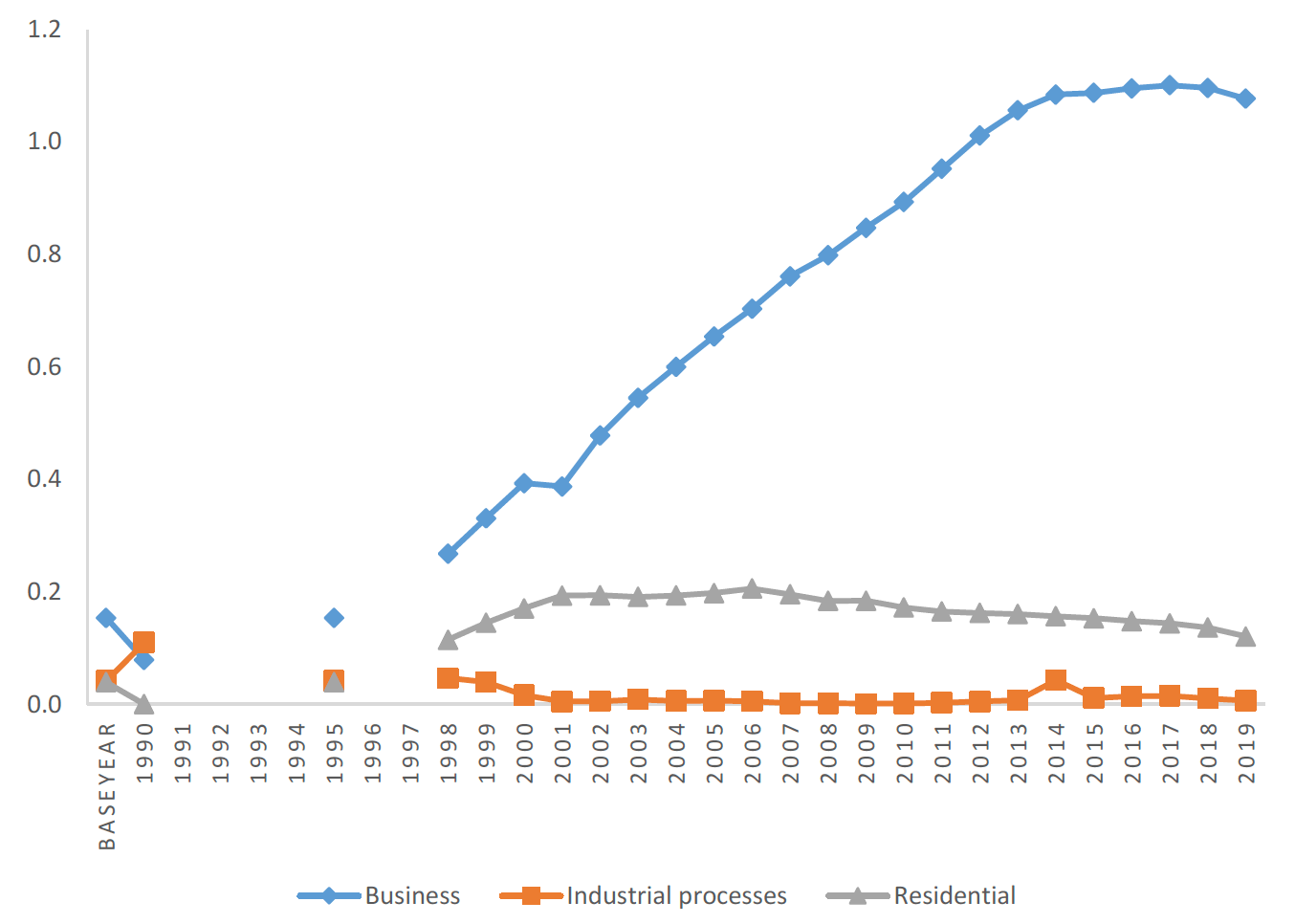
Main Points
- F gases are the most potent greenhouse gases with high global warming potentials but they are emitted in very small quantities. As a result, they contribute less to global warming than the other greenhouse gases in Scotland. (For targets these gases use 1995 as a baseline year rather than 1990)
- There is a sharp increase in HFC gases of 1.0 MtCO2e between 1990 and 2019 (from 0.1 MtCO2e in 1995 to 1.1 MtCO2e in 2019). This change is almost entirely in the Business sector. This increase is because F gases were introduced to replace chlorofluorocarbons (CFCs), which were used in appliances such as industrial air conditioning units. CFCs were banned under the Montreal Protocol, as they were contributing to the depletion of the ozone layer.
- F gas emissions in the residential sector result from the use of aerosols and asthma inhalers, and represent around 0.1 MtCO2e in 2019.
| NC category | Baseline period | 1990 | 2015 | 2016 | 2017 | 2018 | 2019 | Change 1990-2019 | % Change 1990-2019 | Change 2018-2019 | % Change 2018-2019 |
|---|---|---|---|---|---|---|---|---|---|---|---|
| Agriculture | 8.6 | 8.6 | 7.5 | 7.5 | 7.5 | 7.5 | 7.5 | - 1.1 | -12.7% | 0.0 | 0.2% |
| Business | 12.5 | 12.4 | 8.1 | 8.2 | 8.5 | 8.5 | 7.9 | - 4.6 | -36.7% | - 0.6 | -7.3% |
| Energy Supply | 22.7 | 22.7 | 12.2 | 7.4 | 6.0 | 6.8 | 6.4 | -16.3 | -71.8% | - 0.4 | -6.1% |
| Industrial Processes | 1.9 | 1.9 | 0.4 | 0.5 | 0.5 | 0.5 | 0.5 | - 1.4 | -73.1% | - 0.0 | -2.8% |
| International Aviation and Shipping | 1.3 | 1.3 | 1.7 | 1.8 | 1.9 | 1.9 | 1.9 | 0.6 | 46.0% | 0.0 | 0.1% |
| Land Use, Land Use Change And Forestry | 9.1 | 9.1 | 2.2 | 1.8 | 1.7 | 2.3 | 2.7 | - 6.4 | -70.0% | 0.4 | 18.4% |
| Public | 1.7 | 1.7 | 1.1 | 1.1 | 1.1 | 1.1 | 1.1 | - 0.6 | -34.9% | - 0.0 | -2.4% |
| Residential | 8.0 | 8.0 | 6.1 | 6.2 | 6.0 | 6.3 | 6.2 | - 1.8 | -22.3% | - 0.1 | -1.5% |
| Transport (domestic) | 13.6 | 13.6 | 12.1 | 12.4 | 12.6 | 12.3 | 12.0 | - 1.5 | -11.3% | - 0.3 | -2.5% |
| Waste Management | 5.8 | 5.8 | 1.7 | 1.6 | 1.6 | 1.6 | 1.5 | - 4.3 | -73.5% | - 0.1 | -3.6% |
| Grand Total | 85.1 | 85.1 | 53.2 | 48.5 | 47.5 | 48.9 | 47.8 | -37.3 | -43.8% | - 1.1 | -2.3% |
(some early years omitted to fit table on page, full table available in the accompanying excel tables file)
| NC category | Baseline period | 1990 | 2015 | 2016 | 2017 | 2018 | 2019 | Change 1990-2019 | % Change 1990-2019 | Change 2018-2019 | % Change 2018-2019 |
|---|---|---|---|---|---|---|---|---|---|---|---|
| Carbon Dioxide | 63.8 | 63.8 | 38.5 | 34.1 | 33.0 | 34.6 | 33.5 | -30.3 | -47.4% | - 1.1 | -3.2% |
| Methane | 16.0 | 16.0 | 9.5 | 9.3 | 9.4 | 9.2 | 9.2 | -6.8 | -42.4% | - 0.0 | -0.1% |
| Nitrous Oxide | 5.1 | 5.1 | 3.9 | 3.8 | 3.9 | 3.8 | 3.8 | -1.3 | -24.9% | 0.1 | 1.4% |
| F Gases, of which… | 0.2 | 0.2 | 1.3 | 1.3 | 1.3 | 1.2 | 1.2 | 1.0 | 539.0% | - 0.0 | -3.1% |
| HFC | 0.1 | 0.0 | 1.1 | 1.1 | 1.1 | 1.1 | 1.0 | 1.0 | 36215.8% | - 0.0 | -4.5% |
| NF3 | 0.0 | 0.0 | 0.0 | 0.0 | 0.0 | 0.0 | 0.0 | 0.0 | 121.0% | 0.0 | 10.0% |
| PFC | 0.1 | 0.1 | 0.1 | 0.1 | 0.1 | 0.2 | 0.2 | 0.0 | 15.6% | 0.0 | 5.5% |
| SF6 | 0.0 | 0.0 | 0.0 | 0.0 | 0.0 | 0.0 | 0.0 | -0.0 | -18.9% | - 0.0 | -0.2% |
| Grand Total | 85.1 | 85.1 | 53.2 | 48.5 | 47.5 | 48.9 | 47.8 | -37.3 | -43.8% | - 1.1 | -2.3% |
(some early years omitted to fit table on page, full table available in the accompanying excel tables file)
Contact
Email: CCStatsModelling@gov.scot
There is a problem
Thanks for your feedback